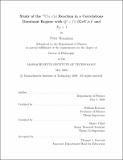Study of the ¹²C(e,e'p) reaction in a correlations dominant regime with Q² = 2.0 (GeV/c)² and XB̳ > 1
Author(s)
Monaghan, Peter (Peter Andrew)
DownloadFull printable version (13.01Mb)
Other Contributors
Massachusetts Institute of Technology. Dept. of Physics.
Advisor
William Bertozzi and Shalev Gilad.
Terms of use
Metadata
Show full item recordAbstract
This experiment was motivated by studying short-range nucleon-nucleon correlations via multinucleon knockout reactions -- (e, e'pN). The data were taken in Hall A at Jefferson Lab using the pair of high resolution spectrometers to detect the (e, e'p) reaction data, and using a third large acceptance spectrometer called BigBite to detect the second nucleon ejected from the nucleus. The kinematics were chosen to be conducive for studying short-range correlations -- namely a large momentum transfer and xB > 1.The central kinematic values used during the experiment were Q2 = 2 (GeV/c)2 and xB = 1.2, although the spectrometer acceptances resulted in a range of both Q2 and xB being recorded in the data. While the electron spectrometer was unchanged during the experiment, the proton spectrometer was changed to cover a range of missing momentum values, ~Pm ~ 200 - 650 MeV/c; this resulted in three different datasets. This thesis presents the analysis and results of the (e, e'p) reaction channel. The motivation of the experiment is discussed and a description of the experimental equipment is given. The methods used to calibrate the equipment, improve the analysis software and to extract the cross-sections from the data are described. The cross-section results from both the 12C(e, e'p)11B bound state and the 12C(e, e'p) continuum reaction channels are presented. The 12C(e, e'p)11B results are compared to theoretical calculations and show agreement for Pm < 300 MeV/c but significant disagreement at larger missing momenta. The data from different kinematic settings which overlap in missing momentum around ~Pm = 400 MeV/c did not provide sufficient statistics to extract a meanful cross-section measurement. The 12C(e, e'p) continuum cross-sections are extracted as a function of missing energy over a range of missing momentum. A peak is observed in the cross-sections as a function of missing momentum; this is consistent with scattering from a quasideuteron pair. However, the peak location is different from the location predicted using the quasideuteron model. (cont.) A suggested modification to the quasideuteron model, namely that the remaining nucleons are not at rest, results in a predicted peak location in the cross-section which lies closer to the observed peak location. The reduced cross-section is also extracted by dividing the results by the single nucleon offshell cross- section; the scc2 prescription of DeForest is used. This reduced cross-section for the same missing momentum and missing energy bins is compared for the three different kinematic settings. No agreement is found between the different datasets showing that the plane-wave impulse approximation does not describe the data. The data presented for the 12C(e, e'p) reaction allows theorists a direct comparison between data and their calculations. We hope it will provide motivation for theorists to improve their calculations and models of the reaction mechanism. Although no theoretical calculations are currently available for comparison, it is anticipated that they will be available in the near future.
Description
Thesis (Ph. D.)--Massachusetts Institute of Technology, Dept. of Physics, 2008. This electronic version was submitted by the student author. The certified thesis is available in the Institute Archives and Special Collections. Includes bibliographical references (leaves 175-178).
Date issued
2008Department
Massachusetts Institute of Technology. Department of PhysicsPublisher
Massachusetts Institute of Technology
Keywords
Physics.